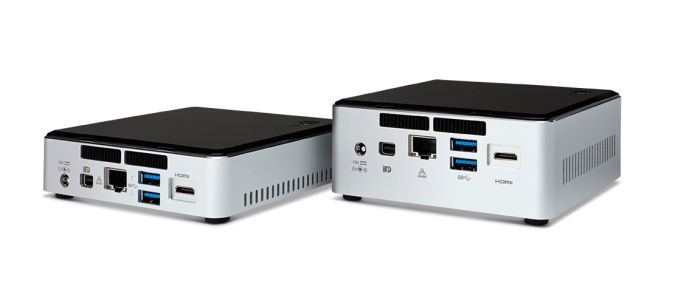Intel NUC5i5RYK Review: A Broadwell-U UCFF PC for Enthusiasts
by Ganesh T S on February 20, 2015 8:00 AM ESTFinal Words
The Intel NUC5i5RYK provided us with the opportunity to take a look at what Broadwell-U can deliver when coupled with a motherboard providing premium features. The migration from 22nm to 14nm has allowed for higher base clocks while maintaining the same power envelop. The performance delta over the Haswell-U-based D54250WYKH (particularly, on the graphics side) is noticeable. That said, while migrating from Sandy Bridge or Ivy Bridge is a no-brainer, there is not enough on offer to recommend migrating from a Haswell-based UCFF PC.
The BIOS in our pre-production review kit had some quirks and the QVL could do with some additions (particularly, support for 2133 MHz DRAM kits would be very welcome). Hopefully, these get fixed as the official market availability date (sometime in March) draws near. We also covered aspects such as replaceable lids for added functionality (NFC and wireless chargining, for example) and customization in our launch piece. Similar to the previous generation NUCs, we also have a kit with support for a 2.5" drive.
The NUC5i5RYK provides an admirable UCFF PC option due to three major aspects:
- Availability of a M.2 PCIe 2.0 x4 slot for SSDs while retaining compatibility with M.2 SATA SSDs
- Presence of an I218-V GbE controller compared to the Realtek-based controllers in other UCFF / mini-PCs
- Upgrade to the Intel AC7265 2x2 802.11ac solution for the WLAN component
There is scope for improvement in terms of the overall feature set. For the home-consumer focused kits, it would be nice if a mini-HDMI to HDMI adapter were to be bundled. Even better would be a full-sized HDMI port - GIGABYTE, ECS and Zotac have shown that it is possible to cram in a full-sized HDMI port even in the NUC form factor. While M.2 PCIe SSD support is a welcome addition, it would be great to get Thunderbolt support back into the NUC ecosystem. For cutting-edge HTPCs, the absence of HDMI 2.0 and full hardware decoding for HEVC streams is a drawback. However, we know that those will definitely be getting fixed in the upcoming generations.
The final aspect we talk about today is the pricing. The NUC5i5RYK seems to be available for $376 on PCConnection as of today (even though Intel indicated a street price slightly north of $400). M.2 SSDs (PCIe or SATA) still carry a premium. For users wishing to keep the build cost down, the NUC5i5RYH model with support for 2.5" drives might be a better option.











83 Comments
View All Comments
extide - Monday, February 23, 2015 - link
No, the article is correct. 1st gen NUC was DCCP847DYE -- which was Celeron 847 -- Sandy Bridge based Celeron.Paapaa125 - Friday, February 20, 2015 - link
Gallery images have very bad underexposure problems. Please pay attention next time: you have to compensate exposure if you have too white background....piasabird - Friday, February 20, 2015 - link
It looks like all Intel did is take an i5 and underclock it down to about half the normal speed. I have an i3 4330 and it runs at 3.5 ghz and has the 4600 graphics and 4 megs of Cache. It runs great. I did turn the power supply that sits above the CPU so it pulls hot air out of the case. I run everything at stock speed with the CPU cooler Intel sold with the retail CPU package. No reason to purchase anything new.piasabird - Friday, February 20, 2015 - link
I liked the way you can select several similar comparisons to compare the review item to. However, I would compare it to a couple i3 processors that might typically be sold for Mini-ITX systems.Aikouka - Friday, February 20, 2015 - link
Does the Broadwell NUC still have the same issue with dropping bitstreaming when turning home theater devices (e.g. TV, AVR, etc.) off and then back on? I ended up getting rid of my Haswell NUC, because I needed something that was more reliable. Amusingly enough, my passively-cooled i3-3225 HTPC works great. It also lacks the weird issue where putting PLEX in the start-up folder on the NUC causes PLEX to improperly connect to the server -- you'd end up seeing the different libraries, but you could never browse them.CSMR - Friday, February 20, 2015 - link
Why isn't the HD6000 graphics with 48EUs dominating the HD5500 graphics with only 24EUs?TheinsanegamerN - Saturday, February 21, 2015 - link
My guess is a combination of lack of memory bandwidth and power restrictions. HD 4600 just barely maxes out 1600MHz memory, and 1866 is barely enough for HD 5500. HD 5200, the previous iris pro, had 72 GB/s of bandwidth, and still had bandwidth issues. 1866 ddr3 is nowhere near fast enough.The second thing is power consumption. HD 4600 in the i5 4300m pulls about 19 watts of power. now, hd 6000 has far more cores, 48 vs 20, which is still too much for 14nm to run on that little power. since the entire TDP is only 15 watt for that cpu, the GPU is both bandwidth restricted and power restricted.
vcorem - Friday, February 20, 2015 - link
The first NUC was IvyBridge, not SandyBridge.It was released in 2012
romrunning - Friday, February 20, 2015 - link
How did the Mainstream setup beat the Enthusiast configuration in the 7-Zip benchmark?!Is that a mistake? Should the labels be switched?
Teknobug - Friday, February 20, 2015 - link
I love my NUC, barely 6W idling and 18W under load, surfs the net great, plays Netflix and YT videos great, plays my Steam games via in-home streaming perfectly.